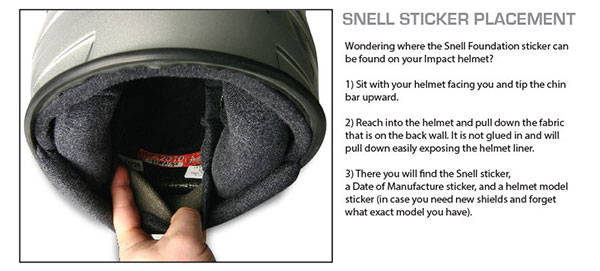Helmet FAQHow do I know what size of helmet I need?As with all personal safety devices, helmet fit is vitally important and can increase the risk of injury if not properly fit. Carefully measure the head approximately one inch above the eyebrows across a point at the back of the head that gives the largest measurement. Please remember: Helmets will "break in" with use. It is important that the helmet fits as tight as one can comfortably withstand to wear. Please see the charts below for helmet fitting. If you do not know your hat size, please take a cloth tape measure and measure around the circumference of your head, just above your brow line. The top chart is for ADULT helmet sizing, the bottom one is for our YOUTH helmet line, which includes inserts that are interchangable to "resize" the helmet from a small to a large.   How do I care for my Impact helmet?PLEASE CAREFULLY READ, UNDERSTAND AND ADHERE TO THE FOLLOWING INFORMATION. SINCE YOUR HELMET IS ENGINEERED TO VERY EXACTING STANDARDS, CORRECT CARE IS VITAL TO ITS PROPER FUNCTIONING.
SHIELD HARDWARE
HELMET CHEEK FIT PADS
HELMET INNER LINER
MINI CHAMP & VAPOR HELMET INSERTS
HELMET HARDWARE
CAUTION!!Read all warning labels and instructions found in, attached to, or included with your helmet. It is extremely dangerous to modify your helmet as it may decrease its effectiveness. Helmets are designed to absorb impact – ONCE. Any helmet involved in an impact should not be used again, even if there is no visual damage. In the event of an impact, return the helmet to IMPACT for inspection. There is a $25.00 charge which includes shipping and handling. The below information and included links were taken direct from the SNELL Memorial Foundation's website and are offered as an additional resource for helmet safety and information: What is the SNELL Foundation?The SNELL Foundation's website can be found here if you are interested in more information on them. Established in 1957 after the tragic death of Pete "William" Snell, the Snell Memorial Foundation has been a leader in helmet safety both in the United States and around the world. For over 50 years, the Snell Memorial Foundation, a not-for-profit organization, has been dedicated exclusively to head protection through scientific and medical research, standards development, helmet testing, and public education. Dr. Snively was the principal architect of the Snell Memorial Foundation. In 1956, at the time of Snell's crash, Dr. Snively had already been interested in helmets and crash injury protection. Fired by Snell's needless death and with the support and encouragement of the SCCA and Pete's friends and loved ones, Snively intensified his efforts. Within a few years, under Snively's leadership, the newly incorporated Snell Memorial Foundation published the first Snell standard for protective headgear. Over the next twenty years, Snively revised this standard continually upward demanding more and more protective performance from the helmet industry. Thanks to the support of the auto racing public, whose numbers were soon swelled by a considerably larger motorcycling public, Snively got that improved performance. Since its founding in 1957, the Snell Memorial Foundation has independently tested manufacturer's helmets. Its first safety standards for protective headgear were issued for auto racing in 1959. Subsequently, other specific helmet standards for motorcycling, equestrian sports, bicycling, rollerblading and skateboarding, snowboarding and skiing, and karting have been issued. These standards address performance, not specific materials or design. Periodically, utilizing specially designed test equipment, the Foundation upgrades its specifications on performance characteristics of helmets to keep pace with advances in materials, helmet technology and design. The SNELL Foundation's FAQ site: Here Where can I find the SNELL Sticker in my helmet?
What radio options do you offer and how can I find out what I need?
We offer kits from Racing Electronics, P.C.I. Race Radios, and Rugged Radio for Off-Road, Stock Car, Open Wheel and Drag Racing. There are three basic styles of jacks and connectors in the motorsports world. Using the proper jack & connector set-up is essential as each form of motorsport has it's own set of wiring standards. An improper jack/conductor system will prevent communication capabilities so be sure to verify the conductor style required for your series prior to ordering. Please contact a sales representative at 317-852-3067 if you need help.  *Drag Radio Kits: Depending on the communications system you and.or you car owner have installed, either the Racing Electronics3=pin "Stock Car" or 4-pin "Open Wheel" radio kits will be what you need to order. Check with your crew chief and just let us know when you order. |